Marquee makeovers
by Matthew | 10 September 2012 8:30 am
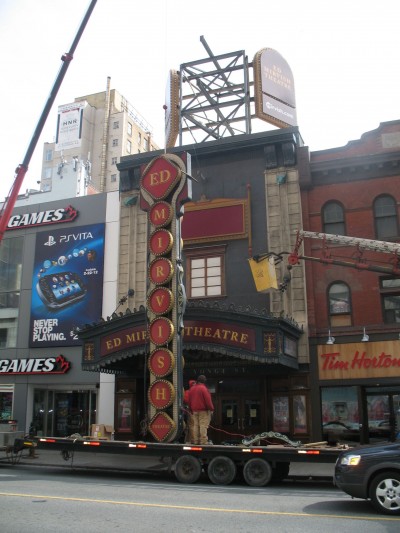 [1]
[1]Photo courtesy ID
By Peter Saunders
Three landmark venues in Toronto have recently seen their marquee signs made over. In each case, there has been an effort to restore a sense of the building’s history, while also newly branding it for future use. Yet, they represent three very different approaches.
Maple Leaf Gardens
The most famous of the venues is Maple Leaf Gardens, which became vacant in 1999 when the local National Hockey League (NHL) team, the Toronto Maple Leafs, began to play home games at a newly built arena, the Air Canada Centre (ACC).
Maple Leaf Gardens was built in 1931 and, though it was often termed a ‘cathedral of hockey, it also hosted major boxing matches, celebrity appearances, rodeos, religious and political speeches, concerts, ballet performances, wrestling bouts and other sporting events over the years. After the Leafs moved out, though, it ended up remaining empty for more than a decade before it was finally rehabilitated and repurposed, reopening in 2012 with a new grocery store on the main level, followed by a Ryerson University athletic centre on the upper level.
Engineering services for the renewal of Maple Leaf Gardens were provided by Exp, based in nearby Brampton, Ont., and formerly known as Trow Engineering. Toronto-based ERA Architects were retained as well, at the earliest stages of the project, as heritage consultants for a range of modifications to the original building.
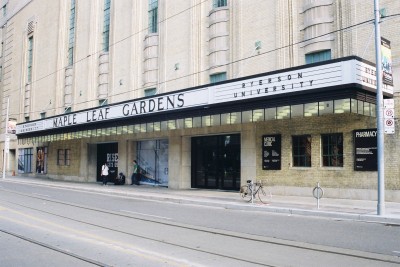 [2]
[2]The new sign is a replica of the Gardens’ most iconic marquee, designed in consultation with municipal heritage preservation services staff. The font was recreated from historic photos. Photo courtesy Exp
The project involved preserving and restoring the building’s architectural heritage elements, including its brick façade, domed roof, window frames and marquee above the main entrance on Carlton Street. ERA supervised the alterations to the designated heritage elements that were retained, directing their restoration.
In the case of the marquee, a replica had to be designed. It had been decided in consultation with municipal heritage preservation services staff to restore this signature element to its most iconic, longest-running incarnation, which was in place from the 1940s—when the marquee was first updated with the addition of a lightbox above the canopy—until the ‘60s.
“We used the original drawings and a number of archival photographs, which had been taken in the 1940s when the marquee was updated,” explains Will MacIvor, ERA’s project architect.
The marquee had subsequently been modified and renovated numerous times over the life of the building, but the historic character of this version of the building’s signage was considered the most clearly defined in the public consciousness. And while not all elements could be kept entirely intact, given the need to accommodate the structural modifications to the building’s interior, the sign’s customized font was carefully recreated from the historic photos and the soffit lighting was restored with the historic round fixtures in a staggered pattern.
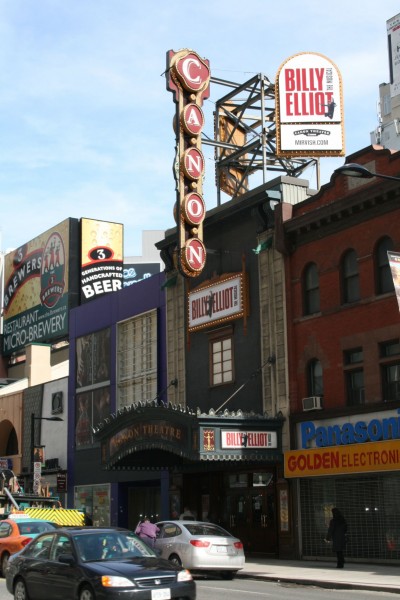 [3]
[3]The Canon Theatre was due for a renaming after the sponsorship deal expired.
“The signage was a priority, because it evoked part of the long history of the former arena, which is recognized as a national historic site,” says Brian Burton, a research and development specialist for Exp.
Exp’s work on the project, which addressed a number of structural and building science challenges, went on to win an Award of Merit from the Consulting Engineers of Ontario.
Ed Mirvish Theatre
Not far north of Maple Leaf Gardens stands the Ed Mirvish Theatre. It originally opened in 1920 as the Pantages Theatre, featuring a mix of movies and vaudeville acts. In 1930, it was renamed the Imperial and dropped the live entertainment, becoming exclusively a cinema for many decades to come.
Finally, in 1989, the building was restored to the 1920 esthetic and reopened as a live theatre. This new Pantages Theatre’s debut show, The Phantom of the Opera, was hugely successful and ran for 10 years. After it closed, there was a change of ownership and a new sponsorship deal, renaming the building the Canon Theatre in 2001. The sign was converted accordingly.
In 2008, the Canon was bought by Mirvish Productions. Once the sponsorship deal expired in 2011, founder David Mirvish decided to rename the venue in honour of his father, theatre impresario Ed Mirvish, who had passed away in 2007. A revised sign was needed.
Toronto-based ID, an independent contractor that has customized illuminated signs since 1995, was hired for the job in March 2012.
“We put a proposal forward to both rename the sign and reduce its energy consumption,” says Paul Kenny, founder and president of ID. “Also, the marquee amendment required a heritage permit from Toronto’s Heritage Preservation Services and a sign permit from the Building Division’s sign bylaw unit. We offered to work directly with the city, whereas another company would go through a third party and take three months instead of a couple of weeks. These days, the design, engineering and permits can be more time-consuming than manufacturing and installation!”
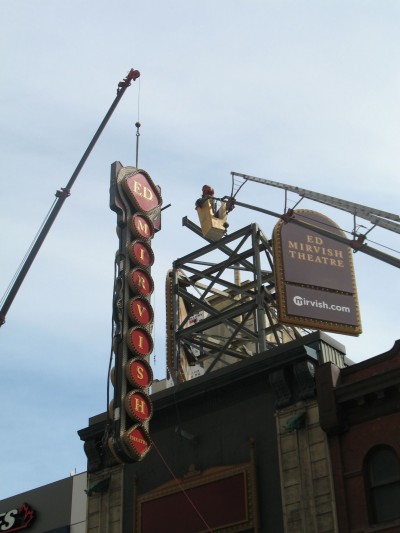 [4]
[4]For the renamed Ed Mirvish Theatre, the sign was refurbished with new aluminum faces, lighting fixtures and internal wiring before it was reinstalled earlier this year.
The 8.5 x 1.8-m (28 x 6-ft) Pantages sign had been built with letters cut into an aluminum background. When the Canon sponsorship deal began, these letters were simply covered up with more aluminum, then new letters in circular sign cabinets were affixed to that surface.
ID took the sign down and refurbished it with LED-illuminated cabinets with routed and infilled aluminum faces.
“We didn’t touch the background,” says Kenny. “We took the old circles off and put new ones on.”
During the refurbishment, some 3,000 11-W incandescent bulbs were removed from the marquee’s perimeter and exterior and replaced with 1.2-W light-emitting diode (LED) fixtures, connected to a mechanical flasher to enable ‘chaser bulb’ animation. As a result, power consumption was cut by 90 per cent.
“The sign now draws approximately 35 A at 120 V,” Kenny explains, “whereas previously, the draw was approximately 300 A.”
Besides the bulb and cabinet replacement, the internal wiring was refurbished, in keeping with the more efficient lighting system.
“The marquee had a cascade of wires inside, leading to every socket,” says Kenny. “We were able to cut out so many circuits.”
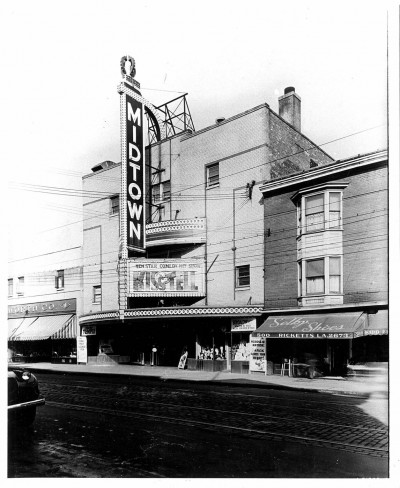 [5]
[5]The Bloor Cinema’s most iconic period was in the 1940s, when it was the Midtown Theatre and featured an enormous, cable-supported marquee. Photos courtesy Hariri Pontarini Architects
The custom LED products were ordered from Edmonton-based LED Lights Canada, which has provided bulbs for other Mirvish Productions venues in the past, including the Royal Alexandra Theatre and the Princess of Wales Theatre.
“These LED bulbs had to have the right base to fit into the sign,” says Kenny. “They provide a whiter, hotter light than many other LEDs, with a better ‘twinkle’ effect for a marquee. There’s been a huge influence on this technology from Las Vegas, Nev., the ‘land of the marquee.’ They’ve been converting sign lighting for years to save on power consumption and we’ve piggybacked on that. Everything’s available now, as long as you order enough of it.”
The rebranded marquee was unveiled to the public with a lighting ceremony on May 2, 2012. Fireworks shot into the air from the roof of the theatre.
“We did the whole thing in five weeks, delivering the sign back in time for the next musical opening,” says Kenny. “The marquee’s even more attractive than before, competing better with other signs nearby.”
He credits the improved esthetics to the use of LEDs.
“LEDs have drastically changed our industry for the better,” he says. “It’s gratifying to install signs that are more efficient and effective. Neon is extremely energy-consumptive and negatively affected by cold temperatures. And white sign lighting used to involve white powdercoating inside a tube with argon and mercury; the mercury would also dissipate in winter, leaving dull, faded and blank spots. LEDs have eliminated those issues.”
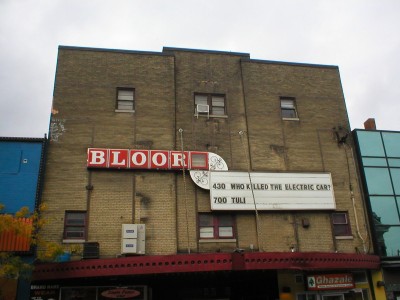 [6]Bloor Hot Docs Cinema
[6]Bloor Hot Docs Cinema
At the same time, to the west in the Annex neighbourhood, the Bloor Cinema was being extensively renovated under the guidance of Toronto-based Hariri Pontarini Architects. Long known as an independent theatre specializing in independent and second-run films, the Bloor was purchased in 2011 by the Blue Ice Group to create a permanent home for Hot Docs, an annual festival of documentaries. Blue Ice would serve as the landlord, Hot Docs the tenant.
The renamed Bloor Hot Docs Cinema promised to screen documentaries year-round. Despite this new, more specialized purpose and the installation of a larger screen, Christie digital projector, surround-sound system, public address (PA) system, acoustical panels and new carpets and wall treatments, Blue Ice also focused on celebrating the building’s past. Seats from the 1940s, for example, were restored for the upper level.
“It’s not a heritage building, but we respected what was there before,” says Patrick Cox, project manager for Hariri Pontarini. “There was an interest both in freshening it up and in being very sensitive to the community. We didn’t want people to notice all the changes inside.”
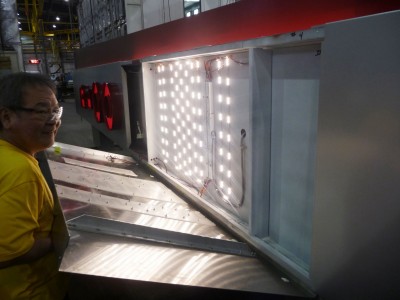 [7]
[7]The new sign would be illuminated with LEDs.
Though these changes were visually subtle, they were legion, requiring many months to complete.
“When the theatre closed in July 2011, Hot Docs said it would reopen that fall,” Cox says, “but the building was an old lady that needed a lot of work to bring her back to her original glory. And when you open up a building as old as this for renovations, there are always surprises you can’t plan for.”
Similar to Maple Leaf Gardens, the Bloor’s most iconic period began in the ‘40s, when it was the Midtown Theatre and featured an enormous, cable-supported marquee. This sign displayed the brightly lit Midtown name perpendicular to the building’s south-facing façade, so it was visible along Bloor Street to the east and west.
The Bloor Cinema sign, by contrast, was installed in the 1980s flush to the wall, so it faced across the street. Blue Ice decided to return to the Midtown era somewhat, with an art deco-inspired—but decidedly modern—sign that could again be seen far along Bloor Street.
“The Bloor Cinema sign was on sheet metal lining the wall surface,” says Cox. “At first, Blue Ice was just going to leave it, but once the reopening was pushed back, there was time to change it, starting in December. We couldn’t just paint it, so we took the whole canopy down. We did consider an old-style sign, but the time frame wasn’t quite long enough for that, as we still needed to get a permit and variance from the city, so instead we designed a new red sign to bring attention to the entrance. We’re giving Hot Docs a real presence on the street.”
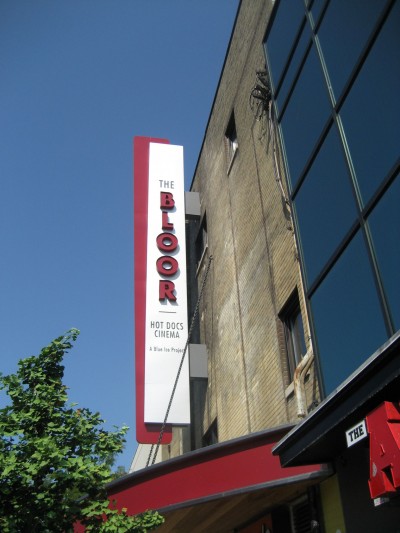 [8]
[8]The new sign provides visibility far along Bloor Street. The dark grey lettering for the words ‘Hot Docs Cinema’ was chosen for its contrast levels by day and night. Photo by Peter Saunders
The architects worked with Hot Docs representatives to design the lettering for the sign. Again with the community in mind, it was seen as more important to emphasize ‘Bloor’ than the Hot Docs brand.
Greenford Construction, the contractor for the renovations, co-ordinated the installation of a structural steel beam and an electrical contractor’s wiring inside the theatre to support the new outdoor sign, which was manufactured and installed by Pattison Sign Group. The beam was connected via steel plates and bolts through the façade to a steel tube outside.
The sign used powdercoated aluminum and red channel letters illuminated by an LED and control panel package from Philips Color Kinetics, designed to provide a warm light. Pattison suggested the dark grey letters for the words ‘Hot Docs Cinema’ because their contrast levels would allow them to be seen clearly day and night.
The cinema reopened in March 2012, in time for the Hot Docs festival in April.
“There’s been a lot of positive feedback on the renovations,” says Cox, who continues to meet with the landlord and tenant to arrange further tweaks to the reborn venue.
With files from Exp, ID and Hariri Pontarini Architects. For more information, visit www.exp.com[9], www.identadvert.com[10] and www.hariripontarini.com[11].
- [Image]: http://www.signmedia.ca/wp-content/uploads/2014/02/IMG_7128.jpg
- [Image]: http://www.signmedia.ca/wp-content/uploads/2014/02/F1000024.jpg
- [Image]: http://www.signmedia.ca/wp-content/uploads/2014/02/Canon-2.jpg
- [Image]: http://www.signmedia.ca/wp-content/uploads/2014/02/IMG_7134.jpg
- [Image]: http://www.signmedia.ca/wp-content/uploads/2014/02/Bloor-Hot-Docs-Cinema_BW-Old-Photos.jpg
- [Image]: http://www.signmedia.ca/wp-content/uploads/2014/02/Bloo-Cinema_old.jpg
- [Image]: http://www.signmedia.ca/wp-content/uploads/2014/02/Bloor-Hot-Docs-Cinema_02.jpg
- [Image]: http://www.signmedia.ca/wp-content/uploads/2014/02/IMG_6515.jpg
- www.exp.com: http://www.exp.com
- www.identadvert.com: http://www.identadvert.com
- www.hariripontarini.com: http://www.hariripontarini.com
Source URL: https://www.signmedia.ca/marquee-makeovers/

